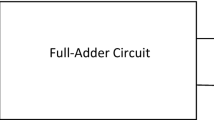Abstract
Pipelining is a popularly used technique to achieve higher frequency of operation of digital signal processing (DSP) applications, by reducing the critical path of circuits. But conventionally critical path is estimated by the discrete component timing model in terms of the times required for the computation of additions and multiplications, where arithmetic circuits are considered as discrete components. Pipeline registers are inserted in between arithmetic circuits to reduce the estimated critical path. In this paper, we show that very often the architecture-level pipelining, based on the discrete component timing model, does not result in significant reduction in critical path, but on the other hand increases the latency and register complexity. In order to derive greater advantage of pipelining, propagation delays of different combinational sections could be evaluated precisely at gate level or at least at the level of one-bit adders, and based on that, the critical path could be reduced by placing the pipeline registers seamlessly across the combinational datapath without restricting them to be placed only in between arithmetic circuits. In this paper, we present adequately precise evaluation of propagation delays across combinational path as a network of arithmetic circuits based on seamless view of signal propagation. Using the precise information of propagation delay of combinational sections, we identify the best possible locations of pipeline registers in order to reduce the critical path up to the desired limit. The proposed seamless pipelining approach is found to achieve the desired acceleration of DSP applications without significant pipeline overhead in terms of latency and register complexity.












Similar content being viewed by others
References
C.R. Baugh, B.A. Wooley, IEEE Trans. Comput. 22(12), 1045–1047 (1973)
S.F. Hsiao, Y.H. Hu, T.B. Juang, C.H. Lee, IEEE Trans. Circuits Syst. I Regul. Pap. 52(8), 1568–1579 (2005)
N. Kumar, M. Bansal, N. Kumar, Int. J. Comput. Appl. 57(11), 14–18 (2012)
I. Kuroda, E. Murata, K. Nadehara, K. Suzukit, A.O. Tomohisa Araitt, in Proc. IEEE Workshop on Signal Processing Systems (SIPS), pp. 381–386, 1998
X. Lou, P. K. Meher, Y. J. Yu, in Proc. IEEE Int. Symp. Circuits Syst, pp. 966–969, 2015
M.D. Macleod, A.G. Dempster, IEEE Signal Process. Lett. 12(3), 186–189 (2005)
R. Mahesh, A.P. Vinod, IEEE Trans. Comput. Aided Des. Integr. Circuits Syst. 27(2), 217–229 (2008)
P.K. Meher, IEEE Trans. Circuits Syst. II Express Briefs 55(9), 902–906 (2008)
P. K. Meher, M. Maheshwari, in Proc. IEEE Int. Symp. Circuits Syst, pp. 121–124, 2011
Y. Pan, P.K. Meher, IEEE Trans. Circuits Syst. I Regul. Pap. 61(2), 455–462 (2014)
B. Parhami, Computer Arithmetic: Algorithms and Hardware Designs (Oxford University Press, New York, 2009)
K.K. Parhi, VLSI Digital Signal Processing Systems: Design and Implementation (Wiley, New York, 1999)
J.M. Rabaey, Low Power Design Essentials (Springer, New York, 2009)
S.K. Sahoo, C. Shekhar, in Proc. IEEE International Conference on Image Information Processing (ICIIP), pp. 1–4, 2011
D. Suvakovic, C. André, T. Salama, in Proc. IEEE Int. Symp. Circuits Syst., pp. 16–19, 2000
C.S. Wallace, IEEE Trans. Electron. Comput. 13(1), 14–18 (1964)
C.H. Yeh, B. Parhami, in Conference Record of the Thirtieth Asilomar Conference on Signals, Systems and Computers, pp. 894–898, 1996
Author information
Authors and Affiliations
Corresponding author
Rights and permissions
About this article
Cite this article
Meher, P.K. Seamless Pipelining of DSP Circuits. Circuits Syst Signal Process 35, 1147–1162 (2016). https://doi.org/10.1007/s00034-015-0089-2
Received:
Revised:
Accepted:
Published:
Issue Date:
DOI: https://doi.org/10.1007/s00034-015-0089-2




